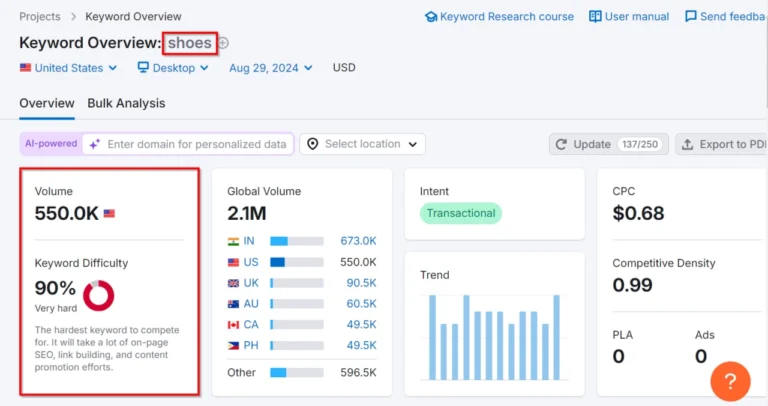So let’s get started. Enter long-tail keywords, a powerful tool in the SEO arsenal that can significantly boost your website’s visibility and attract the right audience. Now let’s dive in.
What are Long-Tail Keywords?
Long-tail keywords are particular, multi-word phrases that users enter into search engines when they are closer to making a purchase or finding exactly what they need.
Unlike short-tail keywords, which are broad and general (e.g., “restaurants“), long-tail keywords are detailed and focused on a niche topic (e.g., “best vegan-friendly restaurants in Brooklyn“). These keywords are called “long-tail” because, on a search frequency graph, they fall on the “long tail” end, representing the less common but more targeted searches.
In essence, long-tail keywords cater to more refined and intent-driven searches, often with lower search volumes but higher conversion rates due to their specificity.
Examples of Long-Tail Keywords
Long-Tail Keywords: Why Specific Searches Matter for SEO
Long-tail keywords also offer a competitive edge by lowering competition. They enable smaller sites to rank higher on search engine results pages (SERPs) because fewer sites target these specific phrases. As a result, targeted traffic from long-tail keywords often leads to higher conversion rates, as users who find your site through these searches are typically further along in their buying journey.
These keywords are more specific, which benefits both users and brands. Users find content that better meets their needs, while brands attract more targeted traffic with less competition. For instance, a search for “best shoes with arch support for flat feet” indicates a user ready to make a decision, unlike a more general search like “shoes“.
Long-tail keywords also offer a competitive edge by lowering competition. They enable smaller sites to rank higher on search engine results pages (SERPs) because fewer sites target these specific phrases. As a result, targeted traffic from long-tail keywords often leads to higher conversion rates, as users who find your site through these searches are typically further along in their buying journey.
How to Find Long-Tail Keywords
Finding the right long-tail keywords for your business doesn’t have to be a daunting task.
- Use Keyword Research Tools: Tools like Ahrefs, SEMrush, and Google’s Keyword Planner are gold mines for finding long-tail keywords. Enter a broad keyword related to your business, and these tools will list longer, more specific phrases.
- Check Out Your Competitors: Look at what keywords your competitors are ranking for. Tools like Ahrefs can show you the keywords driving traffic to their sites. This can give you ideas for your long-tail keywords.
- Answer Common Questions: Think about the questions your customers frequently ask. For example, if you run a pet supply store, your customers might search for “best dog food for puppies with sensitive stomachs.” Create content that answers these questions and targets those long-tail keywords.
- Leverage Forums and Social Media: Visit forums, Reddit threads, and social media groups related to your industry. Pay attention to the questions and discussions. These can provide insights into the long-tail keywords people are using.
Utilizing Long-Tail Keywords in Your Content Strategy
Once you’ve found your long-tail keywords, it’s time to put them to work. Here are some tips for incorporating them into your content:
- Create High-Quality Content: Focus on creating valuable, informative content that addresses the needs and interests of your audience. This will naturally incorporate your long-tail keywords and keep readers engaged.
- Use Keywords Naturally: Avoid keyword stuffing. Instead, use your long-tail keywords naturally within your content. This means including them in headings, subheadings, and throughout the body text in a way that flows smoothly.
- Optimize Meta Tags: Include your long-tail keywords in your meta titles and descriptions. This helps search engines understand what your content is about and can improve your click-through rates. For more insights, check out our blog post.
- Target Multiple Keywords: Don’t just focus on one long-tail keyword per page. Try to target a few related keywords to increase your chances of ranking for different searches.
Measuring Success
So, how do you know if your long-tail keyword strategy is working? Here are a few points of reference that you should pay attention to:
- Organic Traffic: Use tools like Google Analytics to track the amount of organic traffic coming to your site. If your long-tail keywords are working, you should see an increase in visitors.
- Conversion Rates: Monitor your conversion rates to see if more of your visitors are taking the desired actions, whether that’s making a purchase, filling out a form, or signing up for your newsletter.
- Search Engine Rankings: Keep track of your search engine rankings for your targeted long-tail keywords. Tools like Ahrefs or SEMrush can help you see where you stand and how your rankings change over time.
In addition to integrating long-tail keywords strategically into your SEO approach, consider leveraging the expertise of our SEO specialist to maximize their effectiveness organically. Our expert can tailor a comprehensive SEO strategy that aligns these keywords with your company’s unique strengths, goals, and available resources. By doing so, you’ll not only enhance your search engine visibility but also ensure sustainable growth that resonates authentically with your target audience. Take the next step towards optimizing your online presence with our tailored SEO solutions today.








